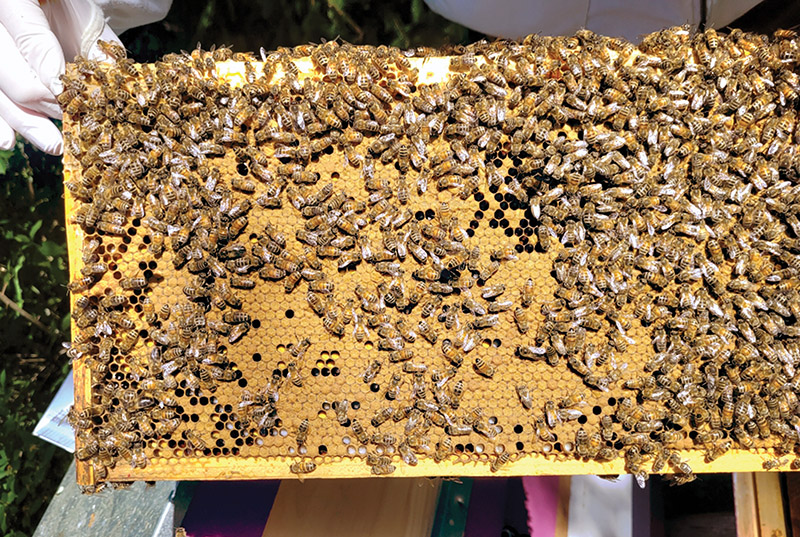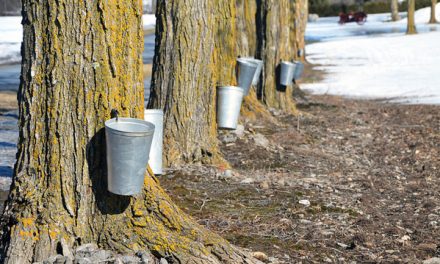Nurse bees on a frame filled with bee brood. Courtesy Photo
CONSTANCE BAY – The historic windstorm, scientifically called a derecho, that swept through parts of Ontario on May 21, is considered to be the sixth largest in terms of insured losses in Canadian history by the Insurance Bureau of Canada.
During the storm 10 people were killed, the electrical grid was significantly compromised and $20 million in damage was reported in Ontario.
Ontario residents could easily see the damage caused by the storm in their neighbourhoods with downed trees and damaged homes. Farmers experienced significant property damage with barns and silos destroyed.
Unseen by many was the destruction of Ontario’s already besieged bee industry.
In some cases beehives were destroyed, but an equally serious situation occurred when queen bees left their hives to mate with drones and were caught miles away from their home hives by the storm. Many queens never made it back home and others were unable to mate with a male bee to ensure the future of the next generation of bees.
The bees we see in our gardens and backyards are doing more than we ever imagined, but they have many challenges apart from terrible weather.
Ian Grant, vice president of the Ontario Bee Association said, “This year has been extremely bad for the bee industry in Ontario and across Canada. Going into last fall we started hearing anecdotal comments and reports from our beekeepers whether they were hobbyists or commercial beekeepers,” he said.
In Ontario there are approximately 3,300 beekeepers and of those, approximately 200 are commercial beekeepers.
The Ontario Beekeeping Association asked its members what kind of year they had.
“Fifty-three per cent of the hobbyists and forty-three per cent of commercial beekeepers said they had lost over half their hives,” said Grant. That number had nothing to do with windstorm but seemed to be part of a trend affecting the Ontario bee population. “The cause was a combination of pests, disease, animal damage.”
Bees are used in Ontario for pollinating crops as well as for producing honey and bee products for the marketplace.
Grant operates his own honeybee operation in Constance Bay, called Bay Bees Honey.
The windstorm was not an expected event.
“This is an added stressor for this year definitely,” said Grant.
“We have six locations where we have our hives, and this has been a labour of love for us,” said Grant. His bees produce about 1,500 pounds of honey each year as well as other bee related products like soaps and candles made from beeswax.
Grant said he is normally very alert to what the weather is doing and as the storm approached his home he noted the different alerts that came with it.
In a matter of minutes he lost several trees on his property. His beehives, which are held down by straps to prevent animals such as bears from opening the tops and enjoying a sweet feast, survived.
The strapping meant that his hives remained intact unlike so many other beekeepers’ hives that experienced significant beehive damage and a resulting loss of bees. However there was another part of Grant’s bee operation which suffered a different storm related consequence.
Whenever a beekeeper is trying to start a new colony of bees, they first begin with a much smaller version of the mature beehive, called a nucleus hive. This small hive is where the queen grows and does not have such a large area to protect. This is the place where the queen and her cohorts will mature and prepare for their future job of populating the larger hives.
“When the queen emerges in the hive she becomes sexually mature in five to seven days. She then goes out on a mating flight looking for male bees to mate with. She will mate with anywhere from 10 to 15 males over that one week span,” said Grant.
Once back in the hive the queen will start to produce more bees.
Grant said, “If the weather is not good enough or the males may not be there or if a storm comes up she may be blown off course or killed.” After the windstorm Grant checked the nuclear hives, and realized that he was not finding the number of queens he should have.
The May 21 storm may have caught many queen bees and male bees out in the open and prevented them from getting together. It must be noted that the average honeybee’s life cycle is only six to eight weeks.
If something like the recent windstorm takes place when the bees are out and about, a large proportion of bee foragers that bring food back to the hive may be lost.
Extreme weather is not the only challenge for bees and the Ontario bee industry.
Grant says it appears he only lost a few of his nuclear hives but he knows of other nuclear hive producers who have lost almost all of their hives due to the storm and are facing a financial loss.
Before the storm, Ontario bees were already facing a number of significant challenges.
The Ontario Beekeepers Association is working with the Ontario Ministry of Agriculture, Food and Rural Affairs to find out what has been decimating Ontario’s bee population. In the meantime, beekeepers are watching the weather for another surprise storm that will add to the stressors bees are already facing.













